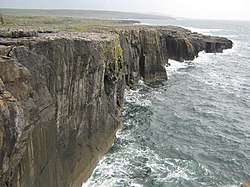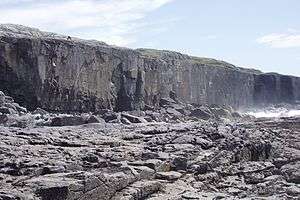Ailladie
| Ailladie | |
|---|---|
| Irish: Aill an Daill; The Blind Man's Cliff | |
 An Falla Uaigneach, the sea cliffs section at the southern end of Ailladie | |
 Location of Ailladie in Ireland | |
| Location | |
| Nearest city |
6 km south of Fanore 8 km north of Doolin |
| Range | The Burren |
| Coordinates | 53°4′22.83″N 9°21′14.64″W / 53.0730083°N 9.3540667°WCoordinates: 53°4′22.83″N 9°21′14.64″W / 53.0730083°N 9.3540667°W |
| Climbing type | |
| Height | circa 35 metres above sea level at its peak |
| Pitches | Single pitch |
| Ratings |
|
| Rock type | Limestone |
| Quantity of rock |
|
| Development |
|
| Cliff aspect | West |
| Elevation | At sea level |
| Camping | |
| Classic climbs |
|
| Website | Climbing.ie Ailladie |
Ailladie (Irish: Aill an Daill; The Blind Man's Cliff) is an 800 metre long west-facing limestone sea-cliff, varying in height from 8 metres to 35 metres, on the coast of The Burren in County Clare, Ireland. It is one of Ireland's most regarded rock-climbing locations. It is also a location for shore-angling competitions, and, with its cliffs and view of the Aran Islands, is a popular photography stop for tourists.

Access
Ailladie is hidden from view, just off the R477 road, 1.5 km before the road turns inland and south-east to Lisdoonvarna. The Ailladie Car Park is marked on many online maps and is just opposite the Stone Wall section of the cliff, at its southernmost end. Access to the base of the cliff, without abseiling, is only possible at the northernmost end, where there is a 3-metre roped fisherman's descent to Ailladie's base, which is a large limestone platform.
The cliff itself straddles the two Clare townlands of Ballyryan (southern section),[1] and Crumlin (northern section).[2]
Rock climbing
Ailladie's northern half, covers the sections known to climbers as the Dancing Ledges and the Aran Wall,[3] and sits above a large rock platform making it accessible, via a 3 metre roped fisherman's descent (a grassy ramp at the northernmost end of Ailladie), regardless of tides. Ailladie climbers also use the climber's descent area at O'Conner's Corner (10 metres, Diff).[4] The Dancing Ledges is the lowest section of Ailladie with several climbs of 10-15 metres.
The first part of Ailladie's southern half is the impressive Mirror Wall (mostly E4-E7), and it is accessible by boulder-hopping at low-tide, although many abseil down to the start of the climbs. The remainder of the southern half of Ailladie, the Stone Wall, An Falla Uaigneach, and Boulder Wall sections, require abseils. The impressive An Falla Uaigneach sector is often into a hanging belay, and offers high-grade deep water soloing ("DWS") at 7c+, but with 30 metre drops.[5]
The rock is limestone, of good clean blue/grey quality and mostly hanging in a sheer vertical form. Its texture varies from smooth, in the few small areas recently exposed by rockfall, to a sharp popcorn texture which provides excellent friction. Most climbs follow steep narrow finger-crack lines, and protection is usually good.[6] The last guidebook, published in 2008, lists 170 climbs (the current Ailladie online database, see below, has over 200), nearly all single-pitch, with grades up to E7 6c. Most Ailladie climbs are at and above, E1 5b grades; there is little quality below VS 4c grade. The lower sections of some routes, and the climbing grade, can change due to the movements of large boulders in sea storms,[6] hence why many Mirror Wall climbers start from a hanging belay.
The climbing potential of Ailladie was discovered in August 1972, when it was visited by a group of Dublin climbers.[7] Word of its quality spread and development began in earnest. Since then, Ailladie has remained at the cutting edge of Irish outdoor traditional rock climbing, along with the dolerite Fair Head cliff in County Antrim.[8][6] UKC describes Ailladie as "Best coastal limestone in the world! Fact!"[9] Ailladie, and the other nearby climbing crags in The Burren area, are the only major on-shore limestone rock climbing locations in Ireland; the others are mainly granite, sandstone and dolerite.[10]
Visiting climbers either camp in the fields above the crag (however, there is no fresh water source), or stay at one of the many hostels in the surrounding villages (particularly Doolin for night-life and additional bouldering,[11] or Fanore for serviced camping grounds). There are several nearby inland 10-20 metre high limestone crags with many graded rock climbs, especially in the grades below VS, that are within walking distance (e.g. Ballyryan), or a short driving distance (e.g. Murroughkilly, Aill na Cronain and Oughtdarra), from Ailladie; however, these do not have anything like the quality or popularity of Ailladie.[12]
Climbing bibliography
- Torrans, Calvin; Stelfox, Dawson (1984). Rock Climbing In Ireland. Constable. ISBN 978-0094653207.
- Torrans, Calvin (1986). Rock Climbing Guide to the Burren. Mountaineering Council of Ireland. ISBN 978-0902940079.
- Torrans, Calvin; Sheridan, Clare (1997). Climbing guide to the Burren. Mountaineering Council of Ireland. ISBN 0-902940-12-0.
- Owens, Peter (2008). Climbs in the Burren and Aran Islands. Mountaineering Ireland. ISBN 0-902940-21-X.
- Flanagan, David (2014). Rock Climbing in Ireland. Three Rock Books. ISBN 978-0956787422.
See also
- Aill na Cronain, inland rock climbing limestone crag in County Clare, right beside the Aillwee Cave
- Ballyryan, inland rock climbing limestone crag in County Clare, right beside Ailladie
- Fair Head, major rock climbing dolerite mountain crag in County Antrim
- Dalkey Quarry, major rock climbing granite quarry in Dublin
| Wikimedia Commons has media related to Ailladie. |
References
- ↑ "Ballyran Townland, Co. Clare". Townland.ie. 2018.
- ↑ "Crumlin Townland, Co. Clare". Townland.ie. 2018.
- ↑ Rob Greenwood (10 June 2017). "Outline of Ailladie's 5 Sectors: Dancing Ledges, Aran Wall, Mirror Wall, Stone Wall, An Falla Uaigneach and Boulder Wall". UKClimbing.com.
- ↑ "Ailladie: Climber's Descent and O'Connors Corner (Dancing Ledges Sector)". climbing.ie.
- ↑ "Colm Shannon's Deserted DWS Heaven - Irish West Coast's Ailladie". UKClimbing.com. 7 August 2016.
- 1 2 3 Rob Greenwood (27 June 2017). "Ailladie, the Burren - Ireland". UKClimbing.com.
- ↑ Paddy O'Leary (2015). "The Way That We Climbed". The Collins Press.
- ↑ Michael Reardon (climber) (9 July 2007). "IRISH VISIT: Ailladie (Burren, Co. Clare)". climbing.com.
The following day brought me to one of my favorite climbing areas on the planet — the great sea cliffs of Ailladie.
- ↑ "Ailladie (Burren, Co. Clare)". UKClimbing.com. 2018.
- ↑ "Rock climbing in Ireland". climb-europe.com. 2018.
- ↑ Peter Owens (2008). "Doolin Bouldering" (PDF). Mountaineering Council of Ireland.
- ↑ "West Clare Crags". UKClimbing.com. 2018.
External links
- Irish climbing.ie Ailladie Online Database
- UK climbing.com Ailladie Online Database
- Forever Young (E7 6c) Ailladie An Falla Uaigneach Sector
- The Ramp (E1 5a 5b) Ailladie Mirror Wall Sector
- Siren (E3 5c) Ailladie Stone Wall Sector
- Eliminator (E5 6b) Ailladie Aran Wall Sector